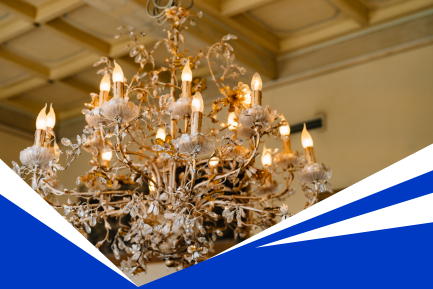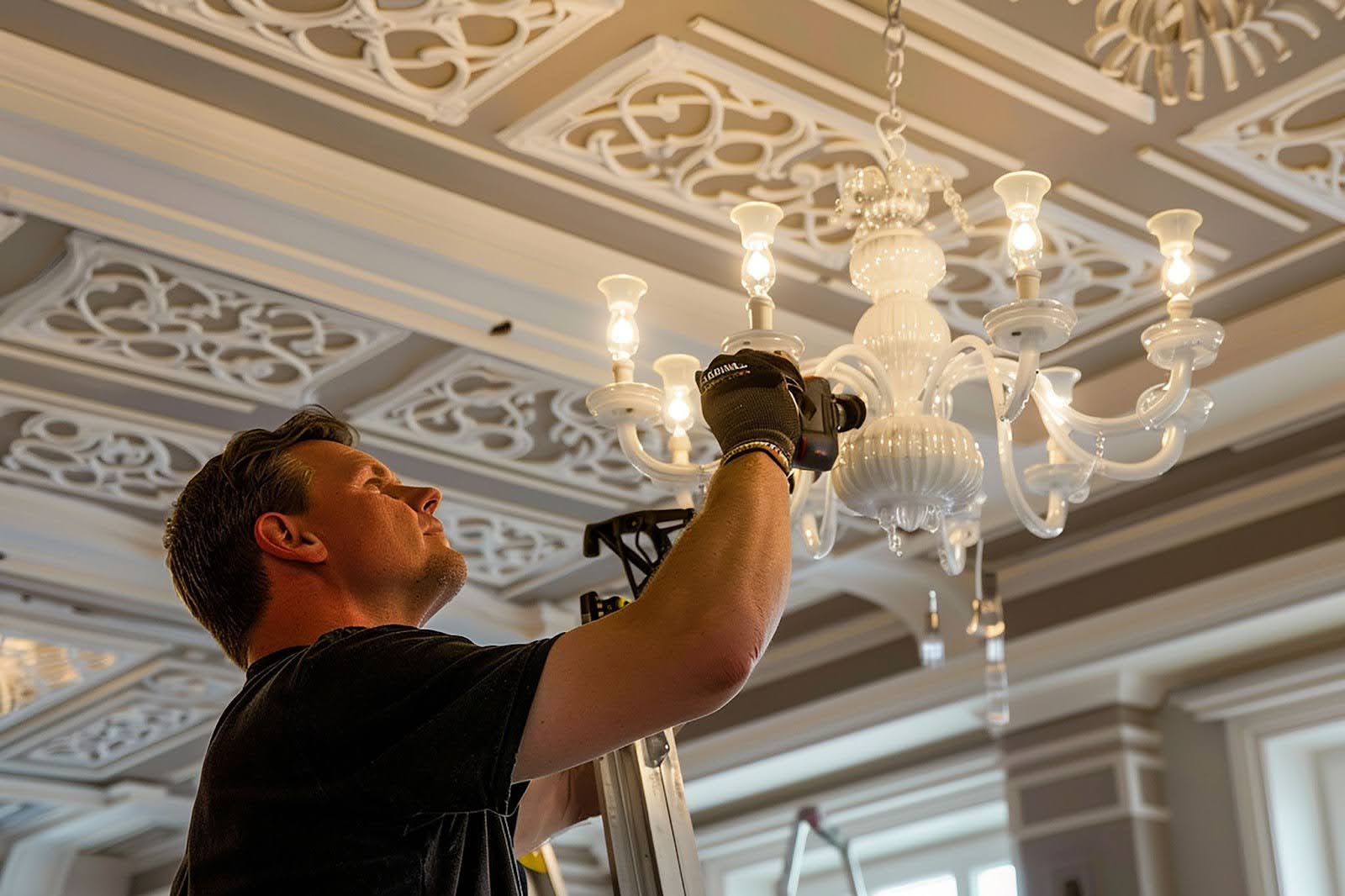How to Pack and Move a Chandelier Without Breaking It

Moving a chandelier isn’t like packing your average household items. These elegant light fixtures come with delicate crystals, intricate wiring, and often weigh more than you’d expect.
Many chandeliers are valuable antiques or custom pieces, which means even the smallest mistake during removal or packing could cost you hundreds (or thousands) of pounds in repairs. Unlike standard light fixtures, chandeliers have multiple breakable components that need careful handling at every stage.
This guide covers everything you need to know about moving your chandelier safely. We’ll walk you through planning and deciding whether to tackle it yourself or call in professional removalists, plus the proper methods for removal, cleaning, disassembly, packing, and transport.
Each step is designed to help you avoid the most common mistakes that lead to damaged fixtures. By the end, you’ll know exactly how to get your chandelier to its new home in perfect condition.
Plan and Prepare Before You Touch the Fixture
Before handling your chandelier, begin by carefully assessing its material, overall size, weight, and the way it’s mounted to the ceiling. Crystal, glass, brass, and antique chandeliers each present unique handling risks, and larger or heavier fixtures may require specialist tools or even custom packing solutions.
Knowing these factors upfront helps you determine the difficulty level and which equipment you’ll need.
Next, decide whether to attempt the removal yourself or call in a professional. If the chandelier is bulky, intricately wired, particularly valuable, or if you’re not experienced with electricals, hiring expert help is safer and may protect your investment. This is especially true for antiques or luxury fixtures.
For less complex, lighter chandeliers, DIY may be suitable if you’re confident in your abilities.
Always start by cutting the power at your consumer unit and use a voltage tester to make absolutely certain the fixture isn’t live before touching any wires. Never skip this step; it’s essential for your safety.
Set up your workspace properly before removal. Lay a heavy blanket or drop cloth beneath the fixture to catch falling pieces or hardware.
Place a stable ladder directly under the chandelier for secure access, and line up containers for organising screws, crystals, and small parts as you remove them.
Ensure you’re dressed for the job: wear non-slip footwear to reduce the risk of slipping, gloves for grip, and safety glasses to shield your eyes from dust or debris. Most importantly, don’t do this alone.
Arrange for at least one helper to steady the chandelier and assist, especially when detaching the fixture and lowering it safely.

Safely Take the Chandelier Down
Start by photographing your chandelier from multiple angles. Capture every wire, fitting, and decorative detail before you begin. These reference images will save you time during reassembly and prevent costly mistakes.
Remove all bulbs, glass shades, crystals, and detachable ornaments before tackling the main fixture. Sort each type of piece into its own labelled container or bag. This prevents mixing up parts and stops accidental damage.
Ask your helper to support the chandelier’s weight while you unscrew the ceiling canopy. This reveals the wiring underneath. Use your voltage tester to double-check there’s no live current running through the wires.
Once you’ve confirmed it’s safe, gently disconnect all wiring and cap the loose ends with wire nuts. This protects them from damage.
With your helper still supporting the fixture, slowly lower the chandelier together. Keep it upright and balanced throughout the process.
Once you’ve got it down safely, make sure those exposed ceiling wires stay capped and protected until you’re ready to reinstall.
Clean Before You Pack
Before packing any chandelier component, start by dusting and gently wiping each piece with a soft, lint-free cloth. This step removes grit or dirt that could cause scratches during the move.
Use only mild solutions like water with a drop of washing-up liquid, or a small amount of diluted vinegar for metal or certain decorative parts. For cleaning crystals or metal components, a mixture of rubbing alcohol and water works well, but avoid ammonia-based cleaners as they can damage finishes.
Never use harsh chemicals on any part of the fixture.
Once cleaned, make sure every component is completely dry before wrapping. Any leftover moisture can lead to water spots, corrosion, or mildew during transport.
Disassemble and Organise Components
With your chandelier cleaned and ready, begin disassembly one section at a time. Remove large detachable parts such as arms, chains, glass panels, and sizable shades in a structured order, making sure a helper always supports the body to prevent strain or accidents.
This step-by-step approach avoids putting pressure on fragile joints.
Organise all crystals by grouping them according to their tier or position on the fixture. Store each group in its own numbered, resealable bag, which streamlines reassembly and prevents loss.
All small hardware, including screws, clips, and hooks, should go into clearly labelled bags or containers.
Wires need careful handling: bundle mains, earth, or decorative wires separately and use cable ties or labels for identification. Never sharply bend the wires. Protect them with foam sleeves or place them in a padded bag to avoid kinks or damage.
Proper organisation and labelling ensure a straightforward, damage-free reinstallation at your new address.
Packing Materials You’ll Need
Before you start packing your chandelier, gather everything you’ll need for the job. A heavy-duty double-walled box works best for most chandeliers. Think dish packs or tall lamp boxes from your local removalist supplies store.
For larger, heavier, or antique pieces, you might need a custom wooden crate instead.
You’ll want plenty of bubble wrap in different sizes, foam sheets, and packing paper for wrapping individual components. Packing peanuts or crumpled newspaper will fill empty spaces and provide that crucial shock absorption.
Don’t forget the basics: strong packing tape to seal everything properly, plus a permanent marker for labelling each box clearly. Small resealable bags or containers are essential for storing bulbs, crystals, and all those tiny screws and fittings.
Keep your electrical components organised with zip ties or twist ties for bundling cords. This prevents tangling and stops wires from getting damaged during transport.
Set up your workspace with a thick blanket underneath to catch any parts that slip from your hands. You’ll need a sturdy ladder for safe access to the fixture, plus basic tools like screwdrivers, pliers, and a voltage tester for handling the electrical connections safely.
Protective gloves give you better grip and prevent fingerprints on delicate surfaces. Having everything ready before you start keeps the whole process organised and reduces the chance of something getting damaged.
Boxing, Crating, and Immobilising
Start by reinforcing your box base with several layers of strong packing tape, extending the tape up the sides by a few centimetres for extra support. Create a thick, shock-absorbing foundation using packing peanuts, foam, or layers of crumpled paper before placing any chandelier parts inside.
Position the main chandelier body upright on this cushioned base. Pack all empty spaces around the fixture with packing peanuts or padded material so nothing can shift, tilt, or wobble during transport.
Keeping each component completely still prevents cracks and internal damage from vibration or sudden jolts.
Pack your delicate pieces like crystals, bulbs, and small fittings in separate smaller boxes or divided compartments. Never cram everything into one box as this raises the risk of pieces knocking together and breaking.
Cushion each item properly within its own space, particularly bulbs and crystals which crack easily.
For the best protection, use the double-boxing method: place your packed inner box inside another larger, well-padded box. Keep at least five centimetres of padding between the two boxes to absorb any shocks during the journey.
Label every side of each box with clear warnings: “Extremely Fragile – Chandelier”, “This Side Up”, and “Do Not Stack”. These labels alert anyone handling your boxes to take extra care, significantly reducing the chance of accidental damage.
DIY, Professionals, and Insurance
DIY is usually best kept for moving smaller, lighter chandeliers, provided you’ve got the right tools, enough time, and a reliable helper. Simple fixtures with basic wiring and detachable components can often be safely removed, packed, and transported yourself if you have steady hands and understand basic electrical safety.
Professional movers become your best choice when dealing with large, antique, high-value, or complex chandeliers, or if you’re uncertain about handling electrical disconnections. Professional removalists in Perth bring experience with delicate fixtures and can handle the risks that come with heavy or intricate ceiling mounts and fragile crystals.
They provide custom crates, thorough padding, and secure packing methods to reduce the risk of breakage.
Moving insurance is strongly recommended for valuable chandeliers. Even experienced hands can face accidents during transport, and insurance protects you from significant loss or repair costs.
If there’s any doubt about your ability to handle the fixture or if the chandelier holds sentimental or financial value, hiring professionals and choosing insurance will give you peace of mind throughout your move.
Mistakes to Avoid
Taking shortcuts when moving a chandelier almost always leads to expensive damage or safety risks. Never skip switching off the power at the circuit breaker and double-checking with a voltage tester before touching any wiring. Electrical accidents are amongst the most common moving injuries.
Don’t attempt removal or lowering without a helper. Chandeliers can be surprisingly heavy and awkward, making solo handling dangerous for both you and the fixture.
Never pack the chandelier frame with crystals still attached. These are likely to chip or snap off under even minor pressure. Remove every crystal and pack them separately in their own cushioned containers.
Inside the box, fill all gaps with soft, shock-absorbing material to stop each part from moving. When components can shift or the body tilts during transport, you’re risking cracks and serious wear.
Don’t stack items on top of the chandelier box, and avoid placing it where it might slide around in the removal vehicle. Vibration and shifting during transport are common causes of hidden damage that only shows up later.
Keep all small parts, screws, hooks, and crystals sorted into clearly labelled and sealed bags according to section or tier. Mixing parts creates confusion and possible loss, which delays reassembly and risks improper installation.
Following these precautions protects your chandelier from breakage and expensive mistakes.
